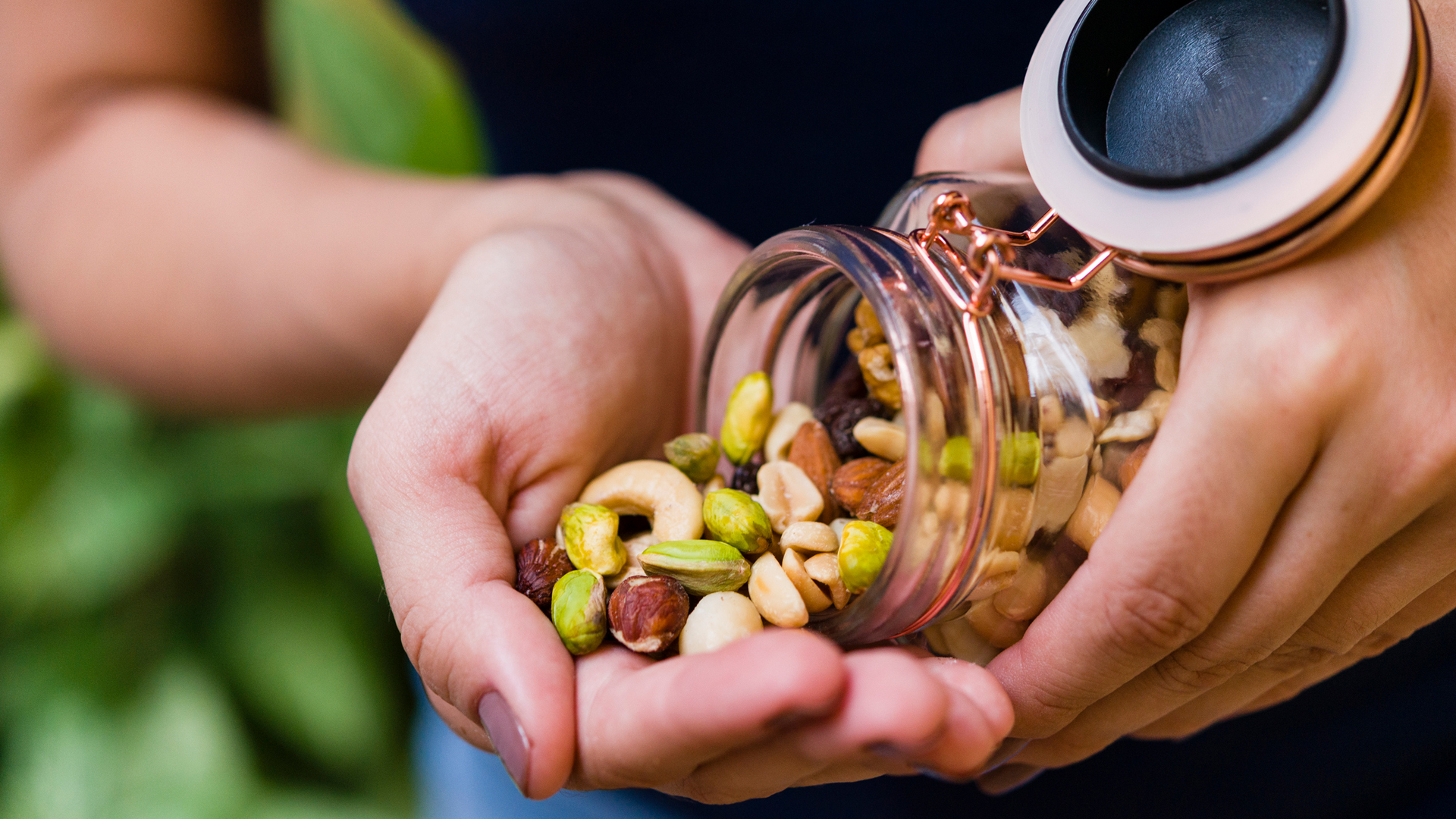Vitamin E: Sources, benefits & risks
Vitamin E is vital to keeping healthy and preventing various diseases. Here's everything you need to know about the 'vitamin of youth'.

Vitamin E, often referred to as the vitamin of youth and beauty, is a nutrient essential for good health. Given that it’s a powerful antioxidant, vitamin E is a common ingredient in anti-aging cosmetics and dietary supplements. And for good reason. This micronutrient has been shown to protect the skin against photodamage and reduce the risk of certain degenerative conditions.
But is vitamin E really the key to healthy aging? Are there any other health benefits linked to this nutrient? And where can you find vitamin E in your diet?
Vitamin E is fat-soluble, meaning that it’s absorbed and transported in a similar way to dietary fat. It’s not a single molecule, but rather a family of several compounds. According to the National Institutes of Health, it occurs naturally in eight forms, including four tocopherols (alpha, beta, gamma and delta) and four tocotrienols. The most common and the most potent form is considered to be alpha tocopherol.
In this article, we’ll look at the health benefits and risks of taking vitamin E. We will also list the best dietary sources of this vital nutrient, as well as signs of potential deficiency. Still, before you consider increasing your vitamin E consumption, it’s best to consult your doctor.
Why do we need vitamin E?
It's a powerful antioxidant
According to a review in the Free Radical Research journal, the primary role of vitamin E is to scavenge free radicals in our bodies. Free radicals are unstable molecules that are either generated in response to normal metabolic processes in our bodies, or come from external sources, like air pollution, tobacco smoke and sun exposure. They have the ability to damage our cells and cause illness by increasing our levels of oxidative stress.
Acting as a powerful antioxidant, vitamin E protects our cells from this oxidative damage and improves our immune responses. According to a review published in the Nutrients journal, vitamin E helps to regulate the production and functioning of a range of white blood cells responsible for fighting off infections. Multiple studies have also demonstrated that the antioxidant properties of vitamin E can help combat allergic diseases.
- Related: Nine sources of vitamin C
It may keep your skin healthy
Vitamin E is mostly known for its beneficial effect on our skin. According to the Journal of Molecular Medicine, it preserves the integrity of skin lipid components and provides protection against UV-induced photodamage. Photoaging contributes to the development of wrinkles, uneven skin texture, hyperpigmentation and discoloration. According to a meta-analysis published in the PLoS One journal, vitamin E may also protect against conditions such as atopic eczema, vitiligo and acne.

It may delay signs of aging
Multiple studies have shown that vitamin E can help improve bone metabolism and prevent osteoporosis, a common condition affecting the elderly population. Another tell-tale sign of aging is sarcopenia – a degenerative muscle condition. And, according to a review published in the Nutrition Research journal, vitamin E can delay the loss of muscle mass and strength, as well as enhance muscle regeneration.
It may help to improve cardiovascular health
There’s also evidence that vitamin E can help improve certain aspects of cardiovascular health. According to a meta-analysis published in the Journal of Human Hypertension, vitamin E supplementation can significantly decrease systolic blood pressure. Whereas other studies reported that this nutrient can help combat inflammation and regulate blood lipid levels, reducing the risk of developing atherosclerosis (the narrowing of the arteries due to the build-up of fatty plaques).
However, as researchers from the Cureus journal point out, there’s no evidence that vitamin E can prevent cardiovascular disease or reduce your likelihood of dying from heart disease.
How much vitamin E should you consume?

According to the National Institutes of Health (NIH), the recommended dietary allowance (RDA) for people over the age of 14 is 15 mg. This amount is also set as vitamin E Daily Value (DV), meaning it’s used as a reference point on the labels of dietary supplements and foods.
Women who are breastfeeding need more – 19 mg – whereas children have lower requirements, starting from 4 mg for infants and rising to 11 mg from ages nine to 13. Tolerable Upper Intake Level (UL) for vitamin E – a maximum daily dose deemed to be safe – is 1,000 mg.
What are the best sources of vitamin E?
Nuts and seeds
- Sunflower seeds: 10 mg (66% DV) per ounce serving
- Almonds: 7.3 mg (48% DV) per ounce serving
- Hazelnuts: 4.3 mg (28% DV) per ounce serving
- Pine nuts: 2.7 mg (18% DV) per ounce serving
- Peanuts: 2.4 mg (16% DV) per ounce serving

Vegetable oils
- Wheat germ oil: 20 mg (135% DV) per tablespoon
- Hazelnut oil: 6.4 mg (43% DV) per tablespoon
- Sunflower oil: 5.6 mg (37% DV) per tablespoon
- Almond oil: 5.3 mg (36% DV) per tablespoon
Fruits and vegetables
- Avocado: 2.1 mg (14% DV) per serving (half a medium-sized fruit)
- Red sweet Pepper (raw): 1.9 mg (13% DV) per one medium pepper
- Mango : 1.5 mg (10% DV) per serving (half a medium-size fruit)
- Kiwifruit: 1 mg (7% DV) per one medium fruit
- Turnip Greens: 1.6 mg (10% DV) per cup
- Butternut Squash (cooked): 1.3 mg (9% DV) per half a cup
- Broccoli (cooked): 1.1 mg (8% DV) per half a cup
Fish
- Abalone: 3.4 mg (23% DV) per serving (3 ounces)
- Atlantic salmon: 2 mg (14% DV) per serving (half a filet)
- Rainbow trout: 2 mg (13% DV) per serving (a filet)
- Crayfish: 1.3 mg (8% DV) per serving (3 ounces)
Vitamin E deficiency
According to the National Institutes of Health, vitamin E deficiency is rare and usually occurs due to fat malabsorption or conditions that prevent the body from fully absorbing certain types of dietary fat. It may also be present in premature babies of low birth weight and in individuals suffering from Crohn’s disease or cystic fibrosis.
Signs of vitamin E deficiency include:
- Anemia
- Skeletal myopathy
- Ataxia (balance and speech disorder)
- Peripheral neuropathy
- Retinopathy (eye disease that can cause blindness)
- Low immunity
- Nerve damage
Vitamin E: Are there any risks?
According to the NIH, the vast majority of people are able to get enough vitamin E from a balanced diet and do not need to supplement. But when supplements are used according to the guidelines, they tend to be tolerated well and do not produce any severe side effects.
However, overdosing on vitamin E can lead to serious health consequences. Because it’s a fat-soluble compound, its excess cannot be washed out with urine. Instead, it’s stored in the body. When the vitamin E reaches a toxic level, it can lead to excessive bleeding, fatigue, nausea, blurred vision and reproductive health problems.
What’s more, vitamin E may interact with certain medications. For example, combining it with anticoagulant or antiplatelet medications may increase your chances of bleeding. Supplementation is also not recommended during cancer therapies, as vitamin E may reduce their effectiveness by protecting the cancerous cells from oxidative damage.
Additional resources
Sign up for the Live Science daily newsletter now
Get the world’s most fascinating discoveries delivered straight to your inbox.

Anna Gora is a health writer at Live Science, having previously worked across Coach, Fit&Well, T3, TechRadar and Tom's Guide. She is a certified personal trainer, nutritionist and health coach with nearly 10 years of professional experience. Anna holds a Bachelor's degree in Nutrition from the Warsaw University of Life Sciences, a Master’s degree in Nutrition, Physical Activity & Public Health from the University of Bristol, as well as various health coaching certificates. She is passionate about empowering people to live a healthy lifestyle and promoting the benefits of a plant-based diet.










